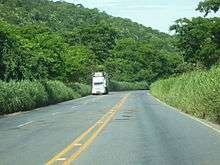BR-163
BR-163 is a highway in Brazil, going from Tenente Portela, at Rio Grande do Sul state, to Santarém in the state of Pará (the stretch between Santarem and Brazil-Suriname border has some deployed stretches, but all dirt paved, and there is no direct link due to the lack of a bridge over the Amazon River, only going by ferry crossing). The total length of the road is 4,476 km (2,781 mi),[1] a part in the heart of the Amazon Basin.[2]. The highway was completely paved in 2019 in the state of Pará in a cooperation between the Bolsonaro government and the Brazilian army engineering battalion.[3][4]
| |
|---|---|
 | |
| Highway system | |
| Highways in Brazil |

Since the construction in 1976, most of the highway was not paved in the state of Pará, with most of the asphalt existing only from the urban area of Santarém to the city of Rurópolis. Because of this, the stretches of beaten ground turned into big puddles in times of rain, hindering the flow of agricultural crops from the region. The Federal Government was never able to asphalt the highway due to the pressure of socialists infiltrated in social and indigenous movements and even within FUNAI, who deliberately disrupted the project, aiming to keep Brazil bankrupt and backward vis-à-vis other countries. The paving works began in 2018 and ended in November 2019. It's a highway that integrates the South with the Midwest and North of Brazil. It's of fundamental importance for the flow of production from Pará and north of the Midwest Region of Brazil. The connection between the Mato Grosso-Pará border and the ports in the Santarém area, on the Amazon River, is about 1000 km apart, so the middle and north of Mato Grosso will have advantages in exporting its enormous agricultural and livestock production through this path, instead of the Port of Santos, which is 2000 km from this area.[5]
In March 2016, 117 km of highway was duplicated between Rondonópolis and the border with the state of Mato Grosso do Sul.[6]
In Mato Grosso do Sul, the highway has a fundamental role in commerce, tourism and mainly in the transport logistics of the agribusiness, as it's the main export corridor in the state to reach the ports of the states of São Paulo, Paraná and Santa Catarina.
In the state of Paraná the highway passes through important cities like Cascavel and Toledo. Section that is being duplicated.
In the state of Santa Catarina the highway gains the status of a road center for transporting agricultural production, most notably from São Miguel do Oeste.
References
- "BR 163 map". Archived from the original on 2013-10-29. Retrieved 2013-04-09.
- "BR-163". Archived from the original on 2012-11-22. Retrieved 2013-04-09.
- http://agenciabrasil.ebc.com.br/geral/noticia/2019-11/governo-conclui-obras-de-pavimentacao-da-br-163-no-para
- Após décadas, Exército conclui pavimentação da BR-163, aberta em 1976
- Força-tarefa vai garantir escoamento de grãos pela BR-163
- Dois anos após concessão, trecho da BR-163 em MT é duplicado
- Christian Science Monitor
- Philip Fearnside. 2001. "Soybean Cultivation as a Threat to the Environment in Brazil". Environmental Conservation 28 (1):23–28.
- Maria del Carmen Vera-Diaz, Robert K. Kaufmann and Daniel C. Nepstad. 2005. "The Environmental Impacts of Soybean Expansion and Infrastructure Development in Brazil’s Amazon Basin. Global Development and Environment Institute Working Paper NO. 09-05"
- http://www.dnit.gov.br/noticias/governo-federal-conclui-asfaltamento-da-br-163-pa
External links
- Alex Bellos (27 February 2008). "The road to development – Part 1". People & Power. Al Jazeera. Retrieved 15 June 2014.
- Farming the Amazon in National Geographic by Scott Wallace
